spark 源码分析之十九 -- DAG的生成和Stage的划分
上篇文章 spark 源码分析之十八 -- Spark存储体系剖析 重点剖析了 Spark的存储体系。从本篇文章开始,剖析Spark作业的调度和计算体系。
在说DAG之前,先简单说一下RDD。
对RDD的整体概括
文档说明如下:

RDD全称Resilient Distributed Dataset,即分布式弹性数据集。它是Spark的基本抽象,代表不可变的可分区的可并行计算的数据集。
RDD的特点:
1. 包含了一系列的分区
2. 在每一个split上执行函数计算
3. 依赖于其他的RDD
4. 对于key-value对的有partitioner
5. 每一个计算有优先计算位置
更多内容可以去看Spark的论文:http://people.csail.mit.edu/matei/papers/2012/nsdi_spark.pdf
RDD的操作
RDD支持两种类型的操作:
- transformation:它从已存在的数据集中创建一个新的数据集。它是懒执行的,即生成RDD的所有操作都是懒执行的,也就是说不会马上计算出结果,它们只会记住它们依赖的基础数据集(文件、MQ等等),等到一个action需要结果返回到driver端的时候,才会执行transform的计算。这种设计使得RDD计算更加高效。
- action:它在数据集上运行计算之后给driver端返回一个值。
注意:reduce 是一个action,而 reduceByKey 则是一个transform,因为它返回的是一个分布式数据集,并没有把数据返回给driver节点。
Action函数
官方提供了RDD的action函数,如下:

注意:这只是常见的函数,并没有列举所有的action函数。
Action函数的特点
那么action函数有哪些特点呢?
根据上面介绍的,即action会返回一个值给driver节点。即它们的函数返回值是一个具体的非RDD类型的值或Unit,而不是RDD类型的值。
Transformation函数
官方提供了Transform 函数,如下:
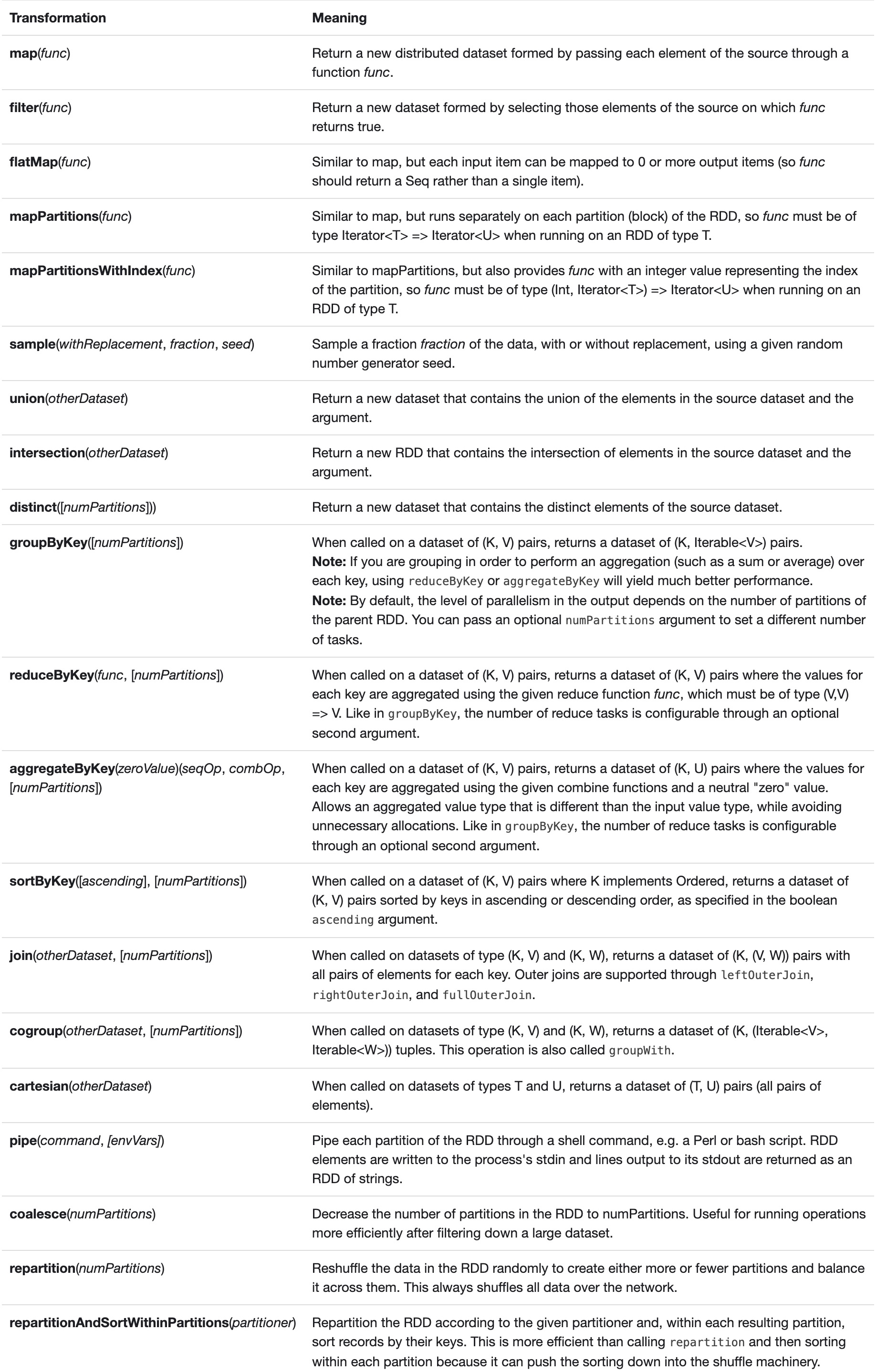
Transformation函数的特点
上文提到,transformation接收一个存在的数据集,并将计算结果作为新的RDD返回。也是就说,它的返回结果是RDD。
总结
其实,理解了action和transformation的特点,看函数的定义就知道是action还是transformation。
RDD的依赖关系
官方文档里,聊完RDD的操作,紧接着就聊了一下shuffle,我们按照这样的顺序来做一下说明。
Shuffle
官方给出的shuffle的解释如下:

注意:shuffle是特定操作才会发生的事情,这跟action和transformation划分没有关系。
官方给出了一些常见的例子。
Operations which can cause a shuffle include repartition operations like repartition and coalesce, ByKey operations (except for counting) like groupByKey and reduceByKey, and join operations like cogroup and join.
RDD的四种依赖关系
那么shuffle跟什么有关系呢?
shuffle跟依赖有关系。在 spark 源码分析之一 -- RDD的四种依赖关系 中,说到 RDD 分为宽依赖和窄依赖,其中窄依赖有三种,一对一依赖、Range依赖、Prune 依赖。宽依赖只有一种,那就是 shuffle 依赖。
即RDD跟父RDD的依赖关系是宽依赖,那么就是父RDD在生成新的子RDD的过程中是存在shuffle过程的。
如图:
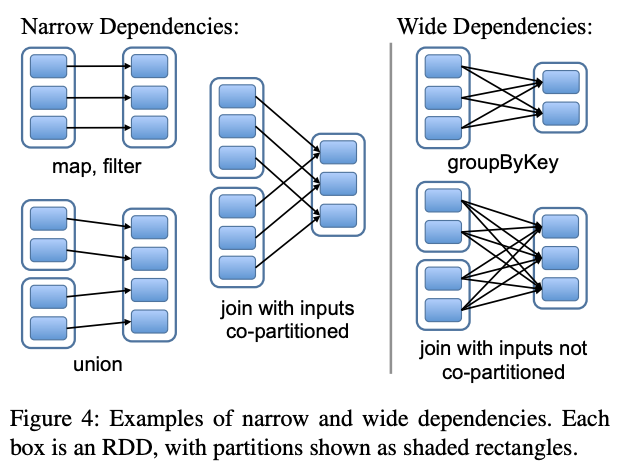
这张图也说明了一个结论,并不是所有的join都是宽依赖。
依赖关系在源码中的体现
我们通常说的 RDD,在Spark中具体表现为一个抽象类,所有的RDD子类继承自该RDD,全称为 org.apache.spark.rdd.RDD,如下:

它有两个参数,一个参数是SparkContext,另一个是deps,即Dependency集合,Dependency是所有依赖的公共父类,即deps保存了父类的依赖关系。
其中,窄依赖的父类是 NarrowDependency, 它的构造方法里是由父RDD这个参数的,宽依赖 ShuffleDependency ,它的构造方法里也是有父RDD这个参数的。
RDD 依赖关系的不确定性
getDependencies 方法
获取抽象的方法是 getDependencies 方法,如下:

这只是定义在RDD抽象父类中的默认方法,不同的子类会有不同的实现。
它在如下类中又重新实现了这个方法,如下:
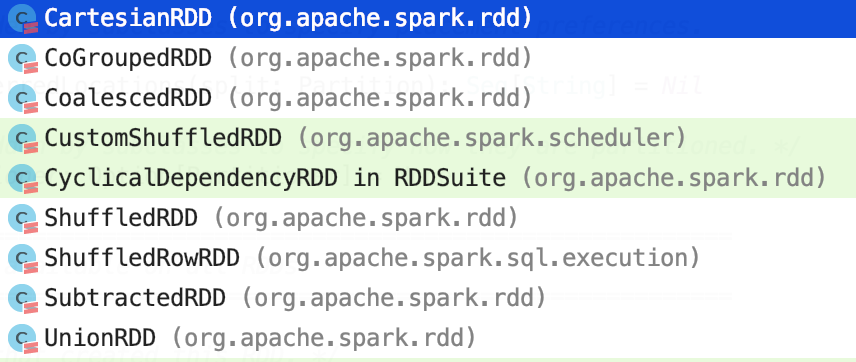
是否是shuffle依赖,跟分区的数量也有一定的关系,具体可以看下面的几个RDD的依赖的实现:
CoGroupedRDD
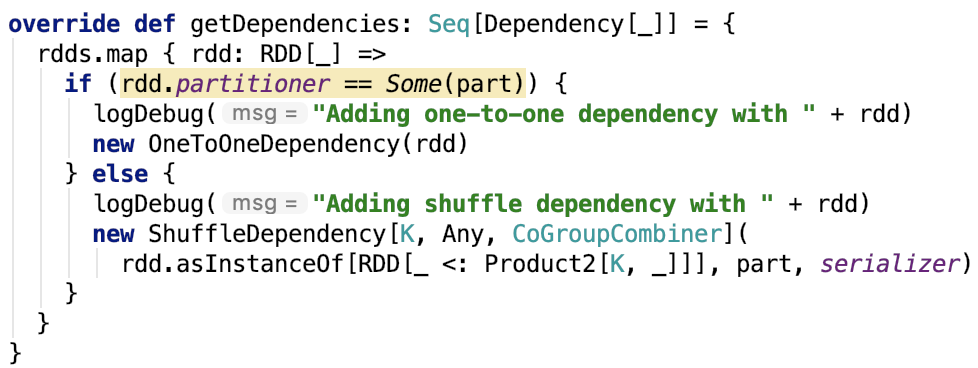
SubtractedRDD
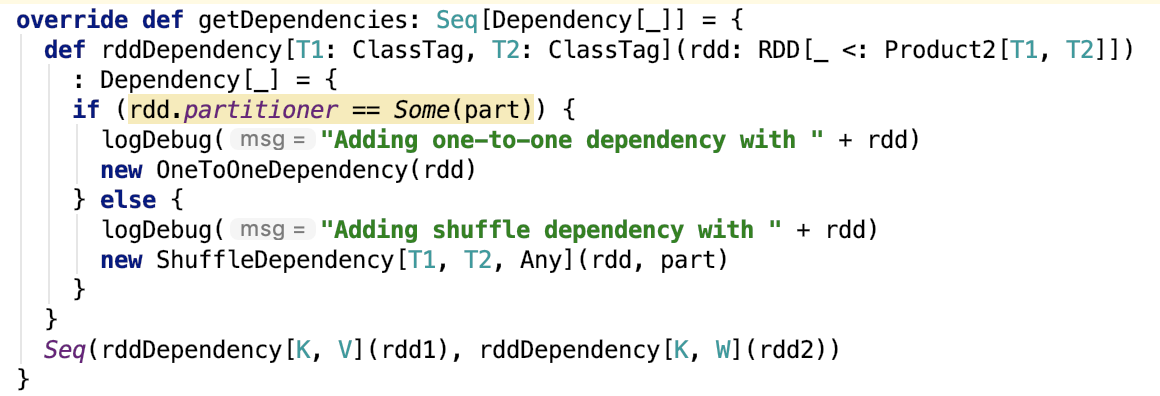
DAG在Spark作业中的重要性
如下图,一个application的执行过程被划分为四个阶段:
阶段一:我们编写driver程序,定义RDD的action和transformation操作。这些依赖关系形成操作的DAG。
阶段二:根据形成的DAG,DAGScheduler将其划分为不同的stage。
阶段三:每一个stage中有一个TaskSet,DAGScheduler将TaskSet交给TaskScheduler去执行,TaskScheduler将任务执行完毕之后结果返回给DAGSCheduler。
阶段四:TaskScheduler将任务分发到每一个Worker节点去执行,并将结果返回给TaskScheduler。
本篇文章的定位就是阶段一和阶段二。后面会介绍阶段三和阶段四。
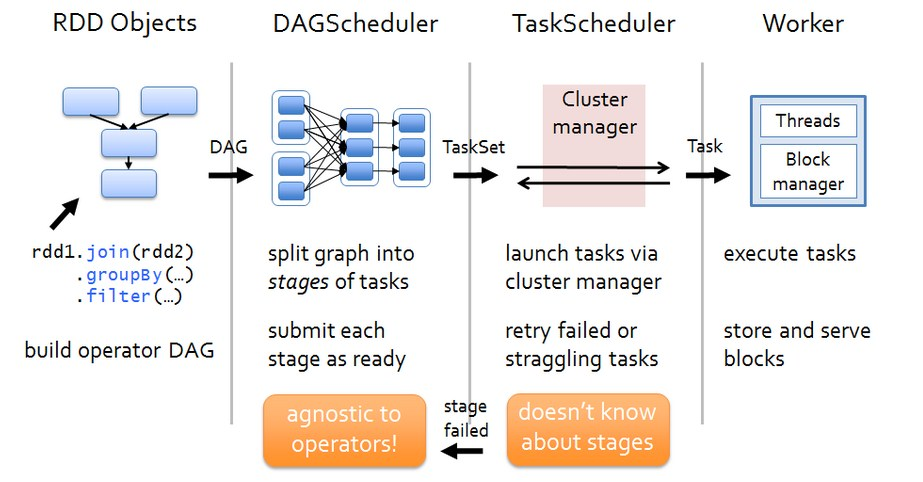
注:图片不知出处。
DAG的创建
我们先来分析一个top N案例。
一个真实的TopN案例
需求:一个大文件里有很多的重复整数,现在求出重复次数最多的前10个数。
代码如下(为了多几个stage,特意加了几个repartition):
scala> val sourceRdd = sc.textFile("/tmp/hive/hive/result",10).repartition(5)
sourceRdd: org.apache.spark.rdd.RDD[String] = MapPartitionsRDD[5] at repartition at <console>:27
scala> val allTopNs = sourceRdd.flatMap(line => line.split(" ")).map(word => (word, 1)).reduceByKey(_+_).repartition(10).sortByKey(ascending = true, 100).map(tup => (tup._2, tup._1)).mapPartitions(
| iter => {
| iter.toList.sortBy(tup => tup._1).takeRight(100).iterator
| }
| ).collect()
// 结果略
scala> val finalTopN = scala.collection.SortedMap.empty[Int, String].++(allTopNs)
//结果略
scala> finalTopN.takeRight(10).foreach(tup => {println(tup._2 + " occurs times : " + tup._1)})
53 occurs times : 1070
147 occurs times : 1072
567 occurs times : 1073
931 occurs times : 1075
267 occurs times : 1077
768 occurs times : 1080
612 occurs times : 1081
877 occurs times : 1082
459 occurs times : 1084
514 occurs times : 1087
下面看一下生成的DAG和Stage
任务概览

Description描述的就是每一个job的最后一个方法。
stage 0 到 3的DAG图:
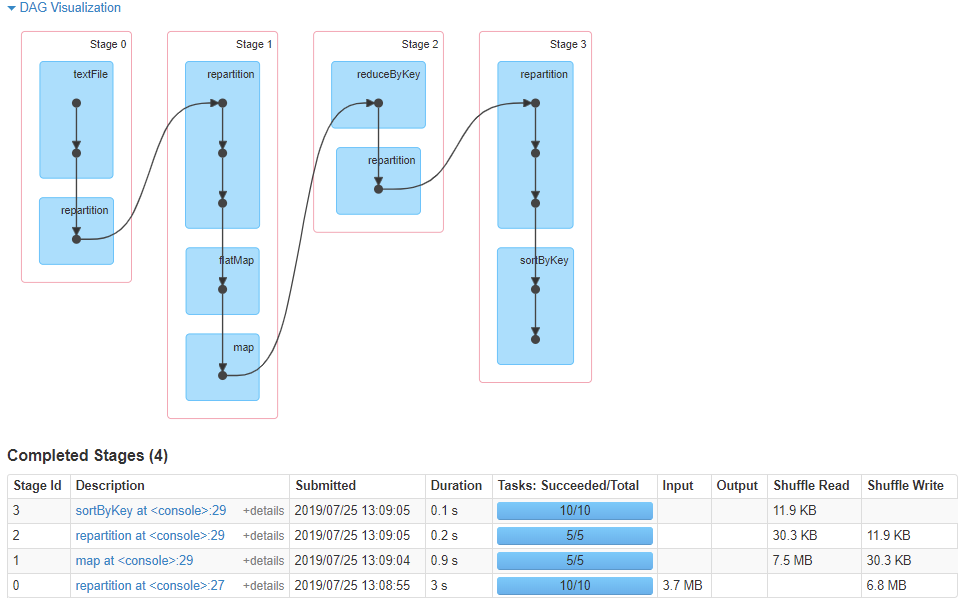
stage 4 到 8的DAG图:

每一个stage的Description描述的是stage的最后一个方法。
总结
可以看出,RDD的依赖关系是有driver端对RDD的操作形成的。
一个Stage中DAG的是根据RDD的依赖来构建的。
我们来看一下源码。
Stage
定义
Stage是一组并行任务,它们都计算需要作为Spark作业的一部分运行的相同功能,其中所有任务具有相同的shuffle依赖。由调度程序运行的每个DAG任务在发生shuffle的边界处被分成多个阶段,然后DAGScheduler以拓扑顺序运行这些阶段。每个Stage都可以是一个shuffle map阶段,在这种情况下,其任务的结果是为其他阶段或结果阶段输入的,在这种情况下,其任务在RDD上运行函数直接计算Spark action(例如count(),save()等)。对于shuffle map阶段,我们还跟踪每个输出分区所在的节点。每个stage还有一个firstJobId,用于识别首次提交stage的作业。使用FIFO调度时,这允许首先计算先前作业的阶段,或者在失败时更快地恢复。最后,由于故障恢复,可以在多次尝试中重新执行单个stage。在这种情况下,Stage对象将跟踪多个StageInfo对象以传递给listener 或Web UI。最近的一个将通过latestInfo访问。
构造方法
Stage是一个抽象类,构造方法如下:
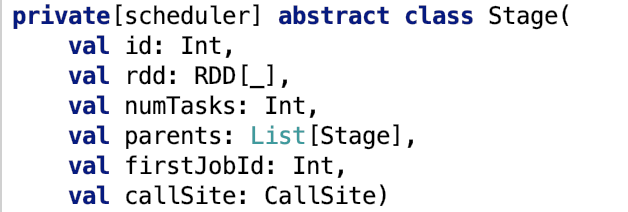
参数介绍如下:
id – Unique stage ID
rdd – RDD that this stage runs on: for a shuffle map stage, it's the RDD we run map tasks on, while for a result stage, it's the target RDD that we ran an action on
numTasks – Total number of tasks in stage; result stages in particular may not need to compute all partitions, e.g. for first(), lookup(), and take().
parents – List of stages that this stage depends on (through shuffle dependencies).
firstJobId – ID of the first job this stage was part of, for FIFO scheduling.
callSite – Location in the user program associated with this stage: either where the target RDD was created, for a shuffle map stage, or where the action for a result stage was called
callSite其实记录的就是stage用户代码的位置。
成员变量

成员方法
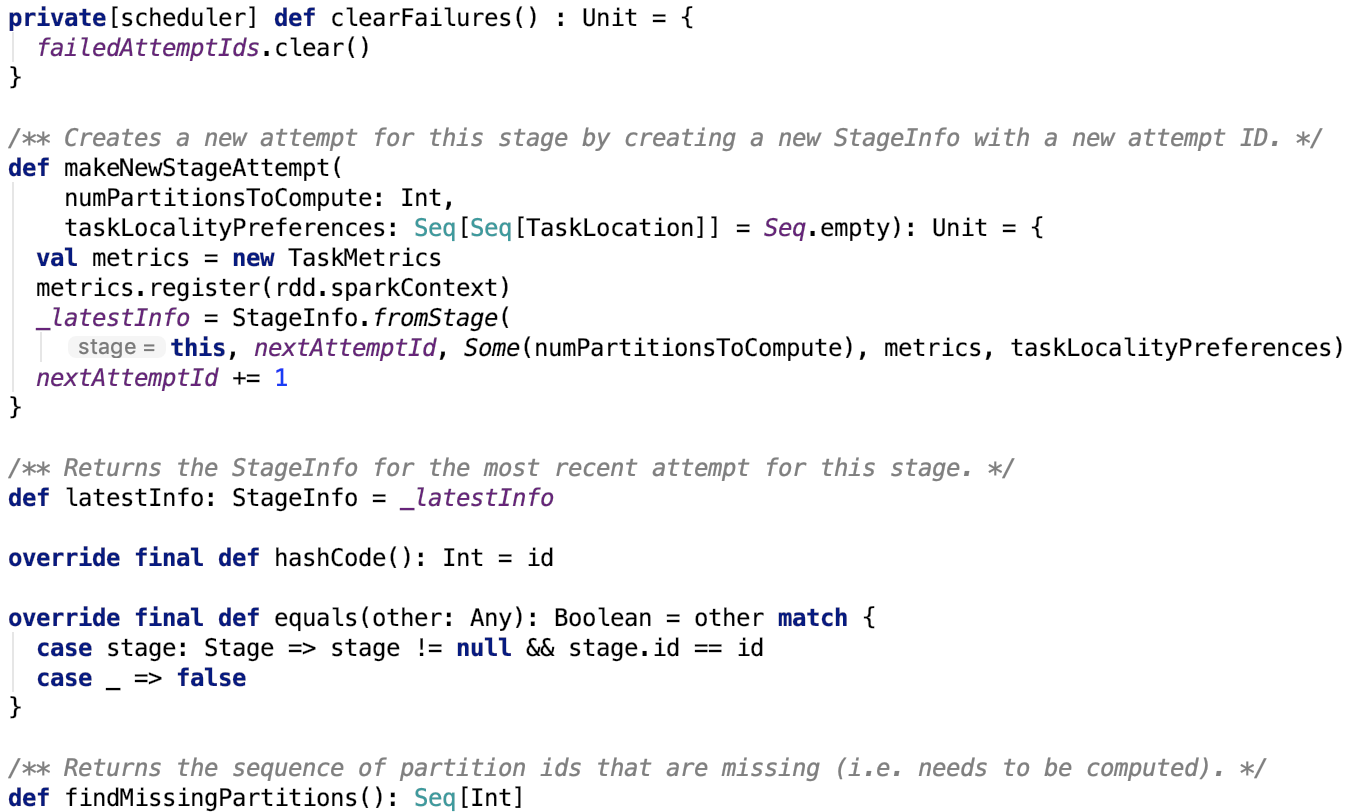
其实相对来说比较简单。
Stage的子类
它有两个子类,如下:

ResultStage
类说明:
ResultStages apply a function on some partitions of an RDD to compute the result of an action.
The ResultStage object captures the function to execute, func, which will be applied to each partition, and the set of partition IDs, partitions.
Some stages may not run on all partitions of the RDD, for actions like first() and lookup().
ResultStage在RDD的某些分区上应用函数来计算action操作的结果。 对于诸如first()和lookup()之类的操作,某些stage可能无法在RDD的所有分区上运行。
简言之,ResultStage是应用action操作在action上进而得出计算结果。
源码如下:

ShuffleMapStage
类说明
ShuffleMapStages are intermediate stages in the execution DAG that produce data for a shuffle.
They occur right before each shuffle operation, and might contain multiple pipelined operations before that (e.g. map and filter).
When executed, they save map output files that can later be fetched by reduce tasks.
The shuffleDep field describes the shuffle each stage is part of, and variables like outputLocs and numAvailableOutputs track how many map outputs are ready.
ShuffleMapStages can also be submitted independently as jobs with DAGScheduler.submitMapStage.
For such stages, the ActiveJobs that submitted them are tracked in mapStageJobs.
Note that there can be multiple ActiveJobs trying to compute the same shuffle map stage.
ShuffleMapStage 是中间的stage,为shuffle生产数据。它们在shuffle之前出现。当执行完毕之后,结果数据被保存,以便reduce 任务可以获取到。
构造方法

shuffleDep记录了每一个stage所属的shuffle。
Stage的划分
在上面我们提到,每一个RDD都有对父RDD的依赖关系,这样的依赖关系形成了一个有向无环图。即DAG。
当一个用户在一个RDD上运行一个action时,调度会检查RDD的血缘关系(即依赖关系)来创建一个stage中的DAG图来执行。
如下图:
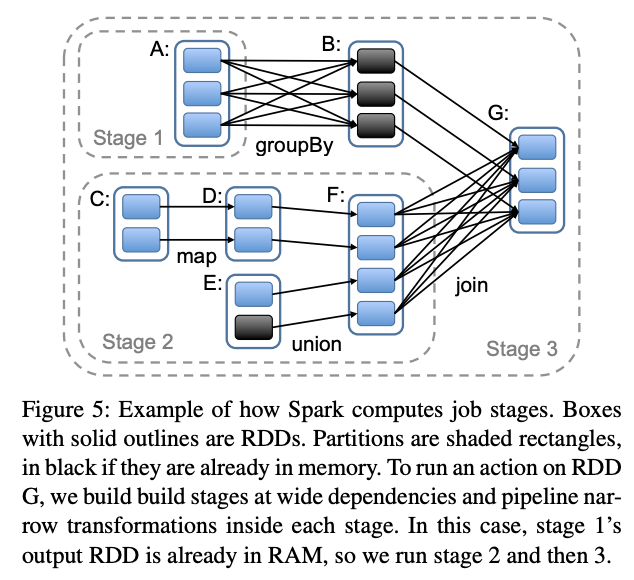
在说stage划分之前先,剖析一下跟DAGScheduler相关的类。
EventLoop
类说明
An event loop to receive events from the caller and process all events in the event thread. It will start an exclusive event thread to process all events.
Note: The event queue will grow indefinitely. So subclasses should make sure onReceive can handle events in time to avoid the potential OOM.
它定义了异步消息处理机制框架。
消息队列
其内部有一个阻塞双端队列,用于存放消息:

post到消息队列
外部线程调用 post 方法将事件post到堵塞队列中:

消费线程
有一个消息的消费线程:
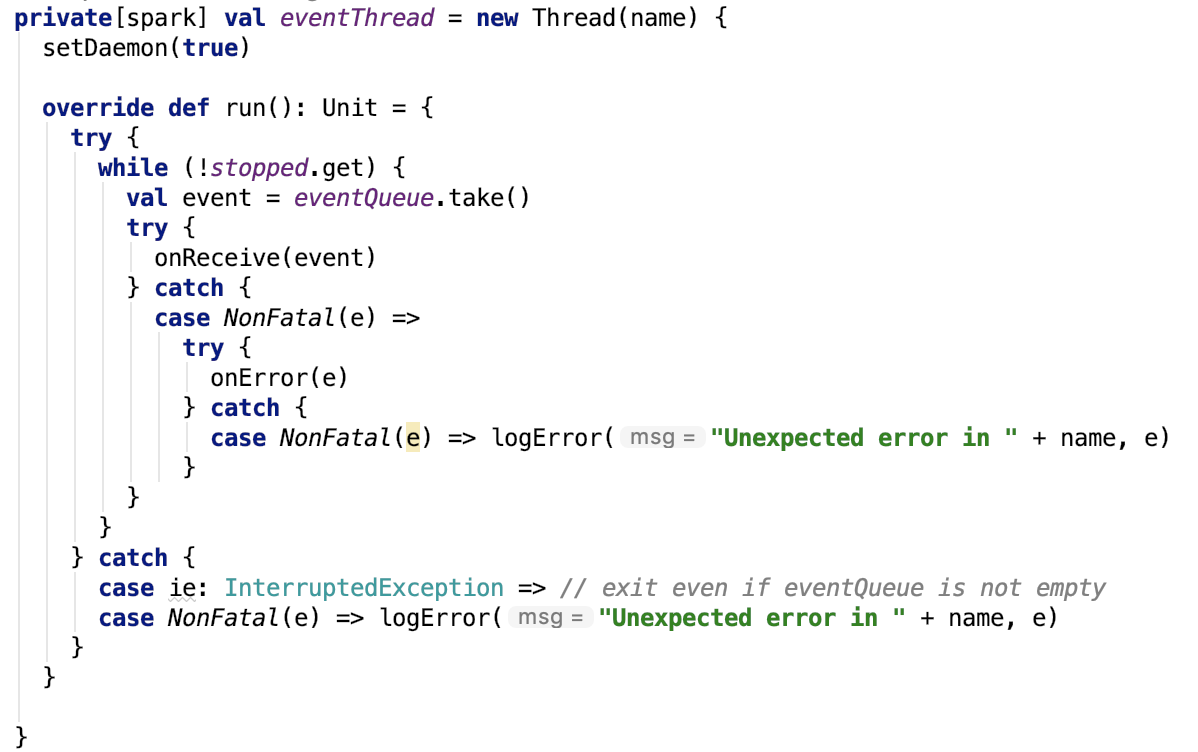
onReceive 方法是一个抽象方法,由子类来实现。
下面来看其实现类 -- DAGSchedulerEventProcessLoop。
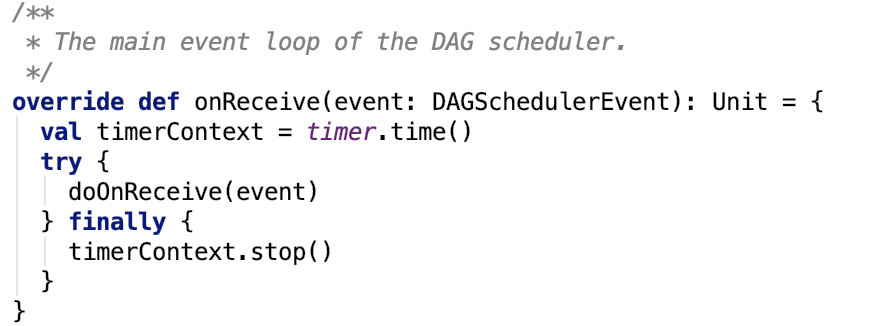
其接收的是DAGSchedulerEvent类型的事件。DAGSchedulerEvent 是一个sealed trait,其实现如下:
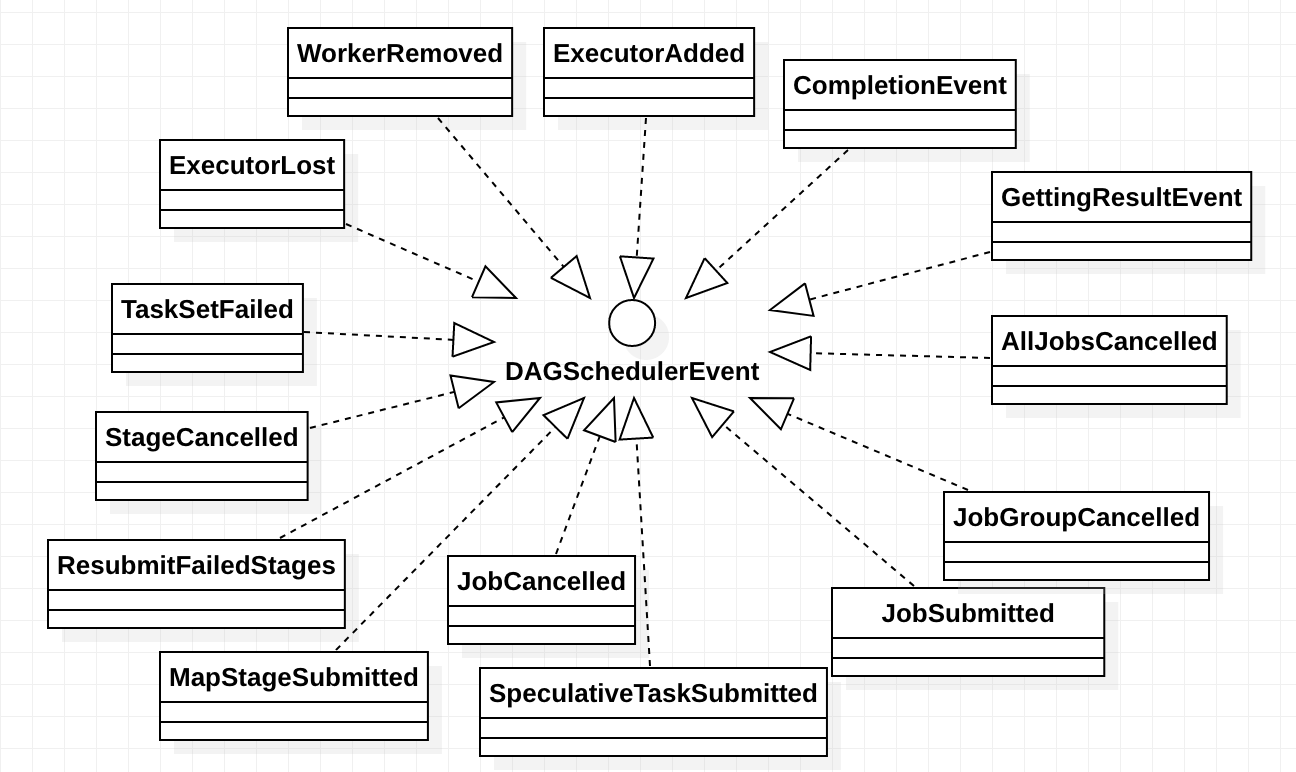
它的每一个子类事件,在doOnReceive 方法中都有体现,如下:
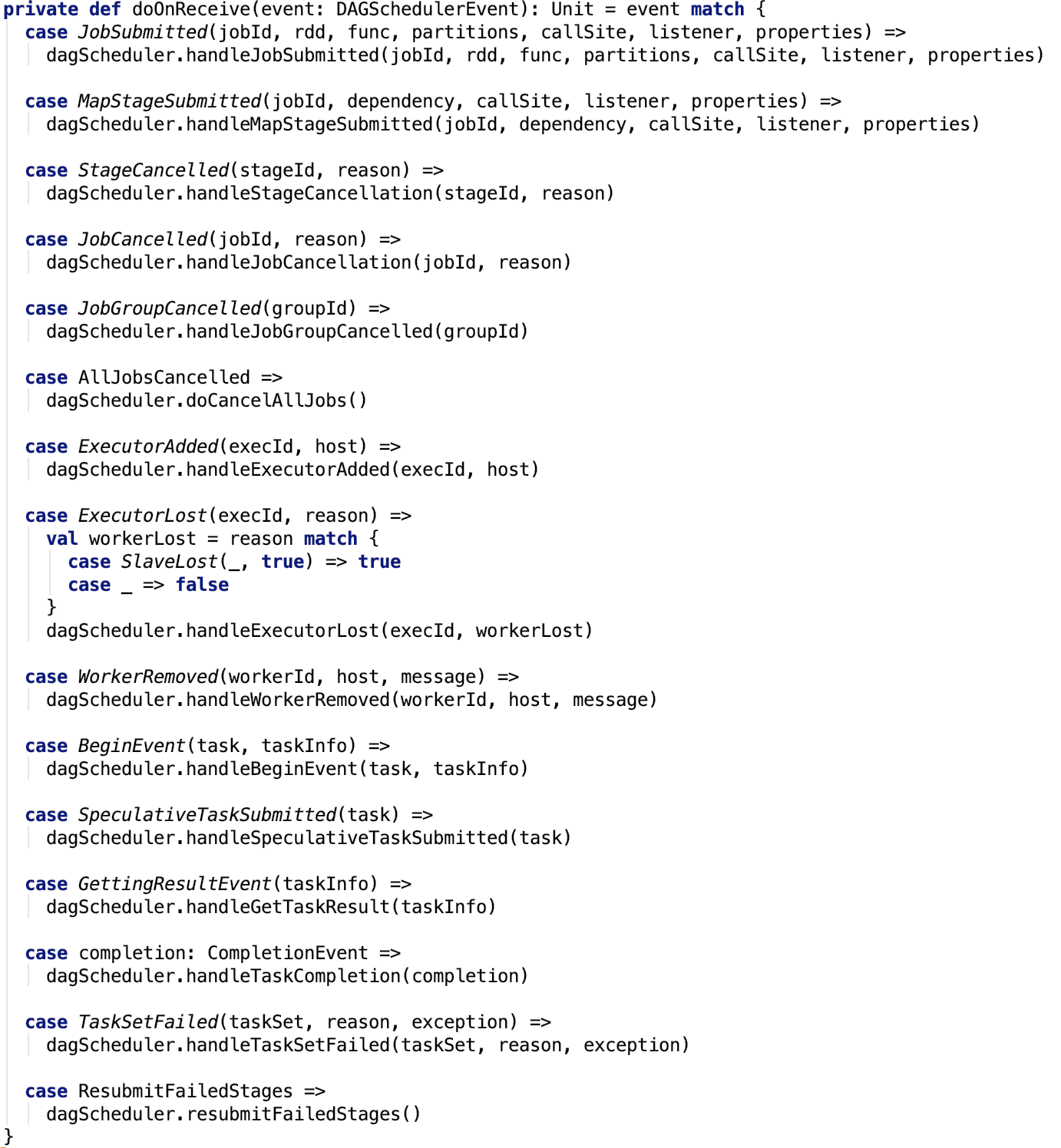
DAGScheduler
这个类的定义已经超过2k行了。所以也不打算全部介绍,本篇文章只介绍跟stage任务的生成相关的属性和方法。
类说明
The high-level scheduling layer that implements stage-oriented scheduling. It computes a DAG of stages for each job, keeps track of which RDDs and stage outputs are materialized, and finds a minimal schedule to run the job. It then submits stages as TaskSets to an underlying TaskScheduler implementation that runs them on the cluster. A TaskSet contains fully independent tasks that can run right away based on the data that's already on the cluster (e.g. map output files from previous stages), though it may fail if this data becomes unavailable.
Spark stages are created by breaking the RDD graph at shuffle boundaries. RDD operations with "narrow" dependencies, like map() and filter(), are pipelined together into one set of tasks in each stage, but operations with shuffle dependencies require multiple stages (one to write a set of map output files, and another to read those files after a barrier). In the end, every stage will have only shuffle dependencies on other stages, and may compute multiple operations inside it. The actual pipelining of these operations happens in the RDD.compute() functions of various RDDs
In addition to coming up with a DAG of stages, the DAGScheduler also determines the preferred locations to run each task on, based on the current cache status, and passes these to the low-level TaskScheduler. Furthermore, it handles failures due to shuffle output files being lost, in which case old stages may need to be resubmitted. Failures within a stage that are not caused by shuffle file loss are handled by the TaskScheduler, which will retry each task a small number of times before cancelling the whole stage. When looking through this code, there are several key concepts:
- Jobs (represented by ActiveJob) are the top-level work items submitted to the scheduler. For example, when the user calls an action, like count(), a job will be submitted through submitJob. Each Job may require the execution of multiple stages to build intermediate data.
- Stages (Stage) are sets of tasks that compute intermediate results in jobs, where each task computes the same function on partitions of the same RDD. Stages are separated at shuffle boundaries, which introduce a barrier (where we must wait for the previous stage to finish to fetch outputs). There are two types of stages: ResultStage, for the final stage that executes an action, and ShuffleMapStage, which writes map output files for a shuffle. Stages are often shared across multiple jobs, if these jobs reuse the same RDDs.
- Tasks are individual units of work, each sent to one machine.
- Cache tracking: the DAGScheduler figures out which RDDs are cached to avoid recomputing them and likewise remembers which shuffle map stages have already produced output files to avoid redoing the map side of a shuffle.
- Preferred locations: the DAGScheduler also computes where to run each task in a stage based on the preferred locations of its underlying RDDs, or the location of cached or shuffle data.
- Cleanup: all data structures are cleared when the running jobs that depend on them finish, to prevent memory leaks in a long-running application.
To recover from failures, the same stage might need to run multiple times, which are called "attempts". If the TaskScheduler reports that a task failed because a map output file from a previous stage was lost, the DAGScheduler resubmits that lost stage. This is detected through a CompletionEvent with FetchFailed, or an ExecutorLost event. The DAGScheduler will wait a small amount of time to see whether other nodes or tasks fail, then resubmit TaskSets for any lost stage(s) that compute the missing tasks. As part of this process, we might also have to create Stage objects for old (finished) stages where we previously cleaned up the Stage object. Since tasks from the old attempt of a stage could still be running, care must be taken to map any events received in the correct Stage object.
Here's a checklist to use when making or reviewing changes to this class:
- All data structures should be cleared when the jobs involving them end to avoid indefinite accumulation of state in long-running programs.
- When adding a new data structure, update DAGSchedulerSuite.assertDataStructuresEmpty to include the new structure. This will help to catch memory leaks.
下面直接来看stage的划分
从源码看Stage的划分
从action函数到DAGScheduler
以collect函数为例。
collect 函数定义如下:

其调用了SparkContext的 runJob 方法,又调用了几次其重载方法最终调用的runJob 方法如下:
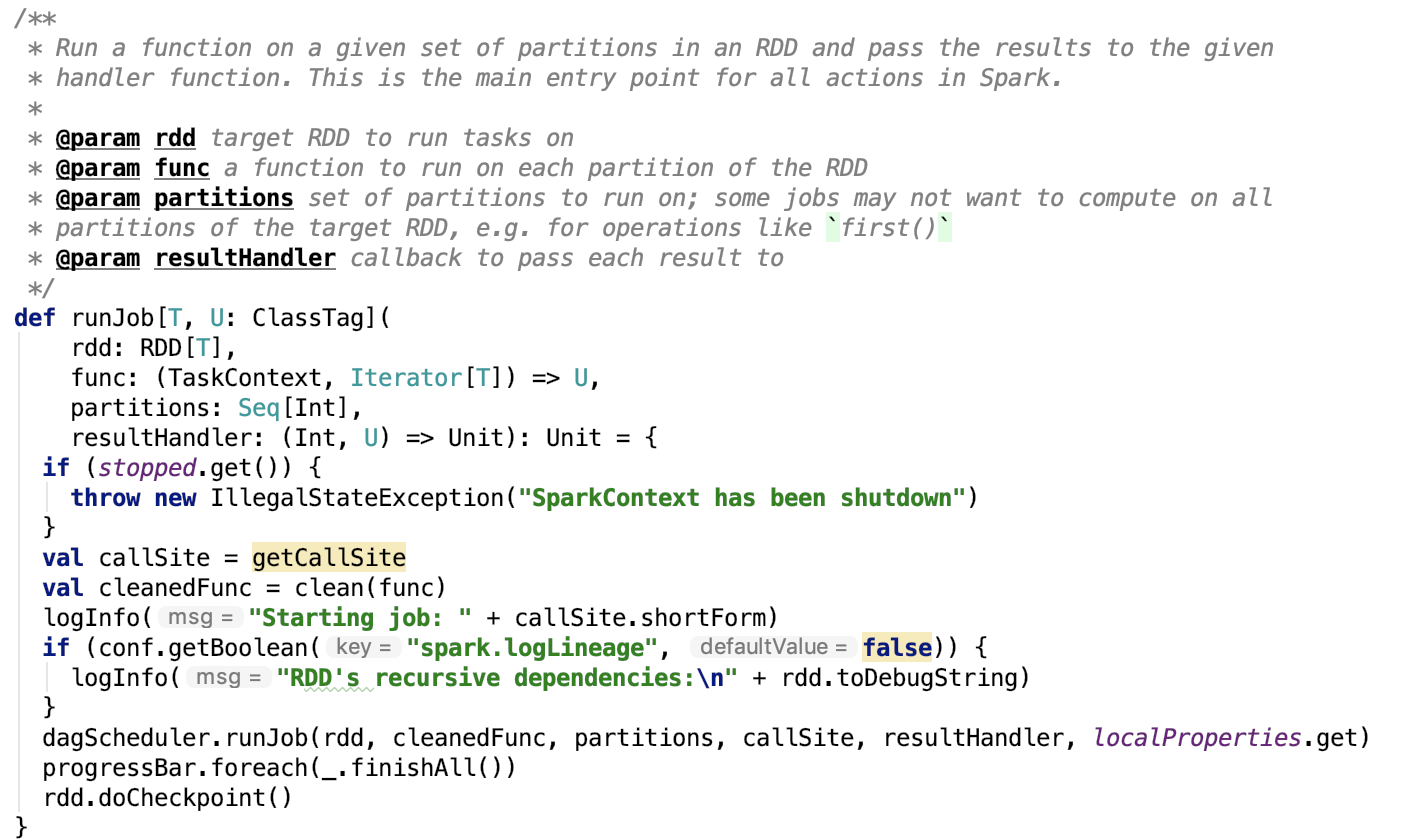
其内部调用了DAGScheduler的runJob 方法
DAGScheduler对stage的划分
DAGScheduler的runJob 方法如下:
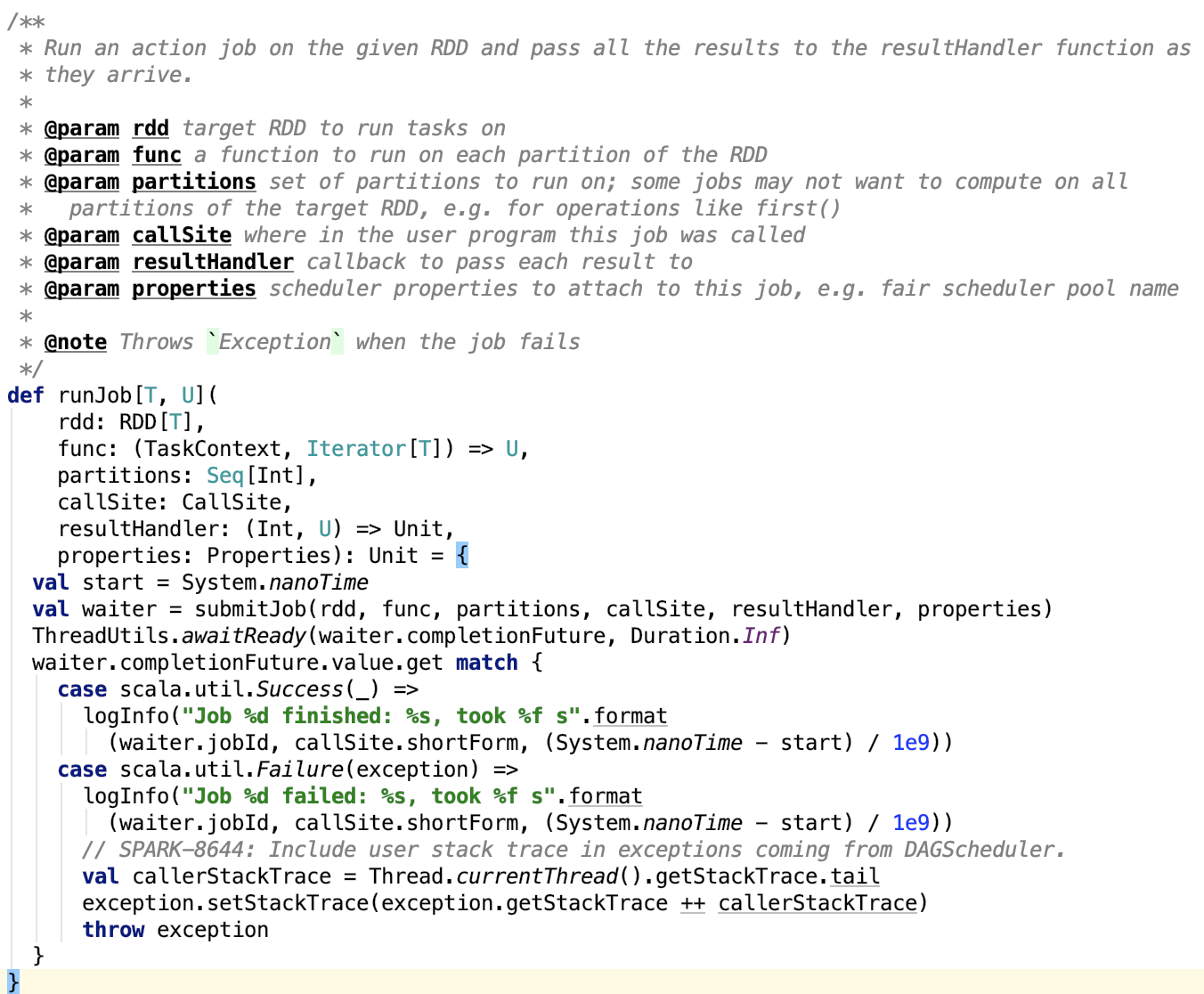
思路,提交方法后返回一个JobWaiter 对象,等待任务执行完成,然后根据任务执行状态去执行对应的成功或失败的方法。
submitJob 如下:
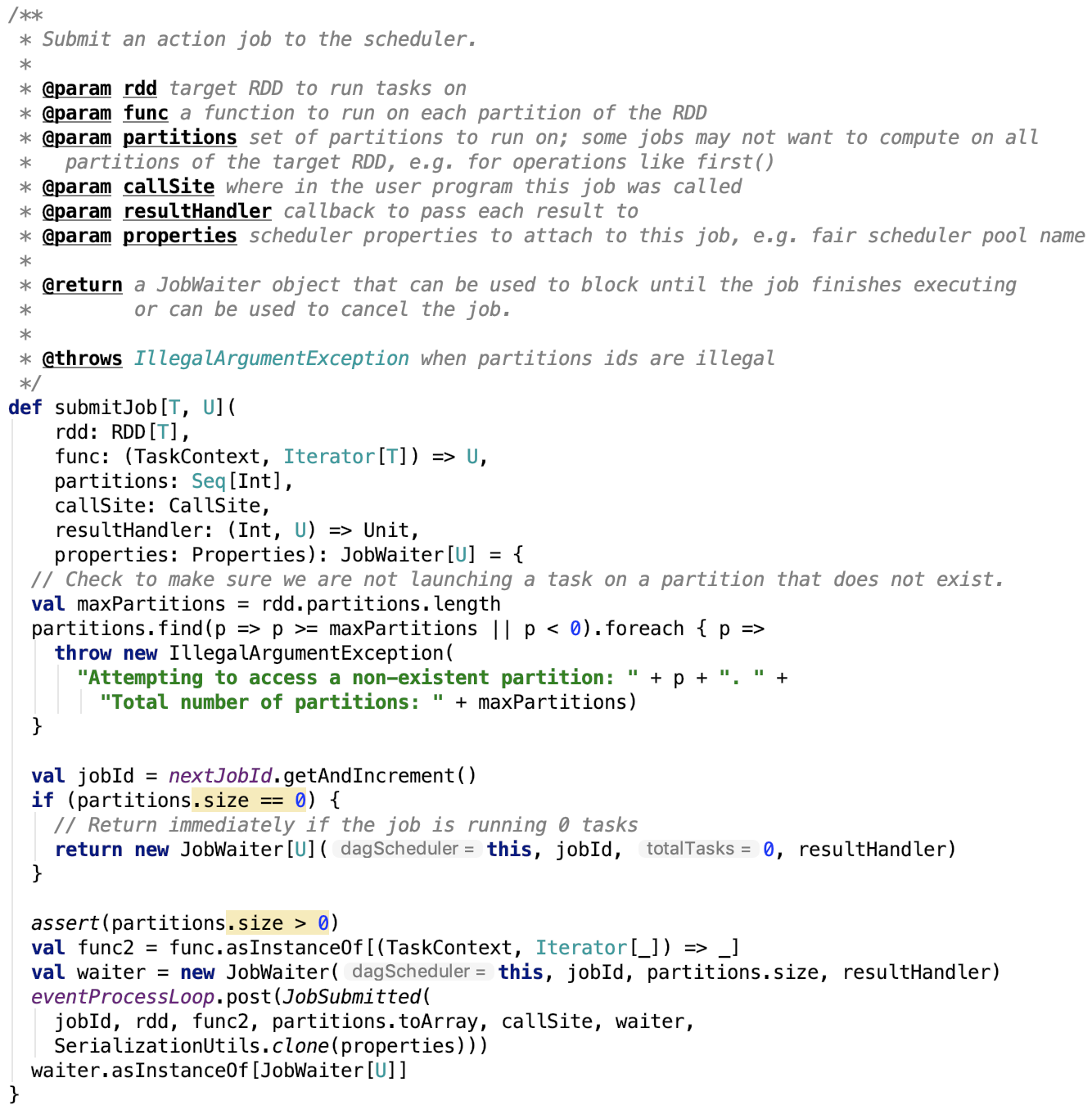
最终任务被封装进了JobSubmitted 事件消息体中,最终该事件消息被放入了eventProcessLoop 对象中,eventProcessLoop定义如下:

即事件被放入到了上面我们提到的 DAGSchedulerEventProcessLoop 异步消息处理模型中。
DAGSchedulerEventProcessLoop 的 doOnReceive 中,发现了 JobSubmitted 事件对应的分支为:

即会执行DAGScheduler的handleJobSubmitted方法,如下:
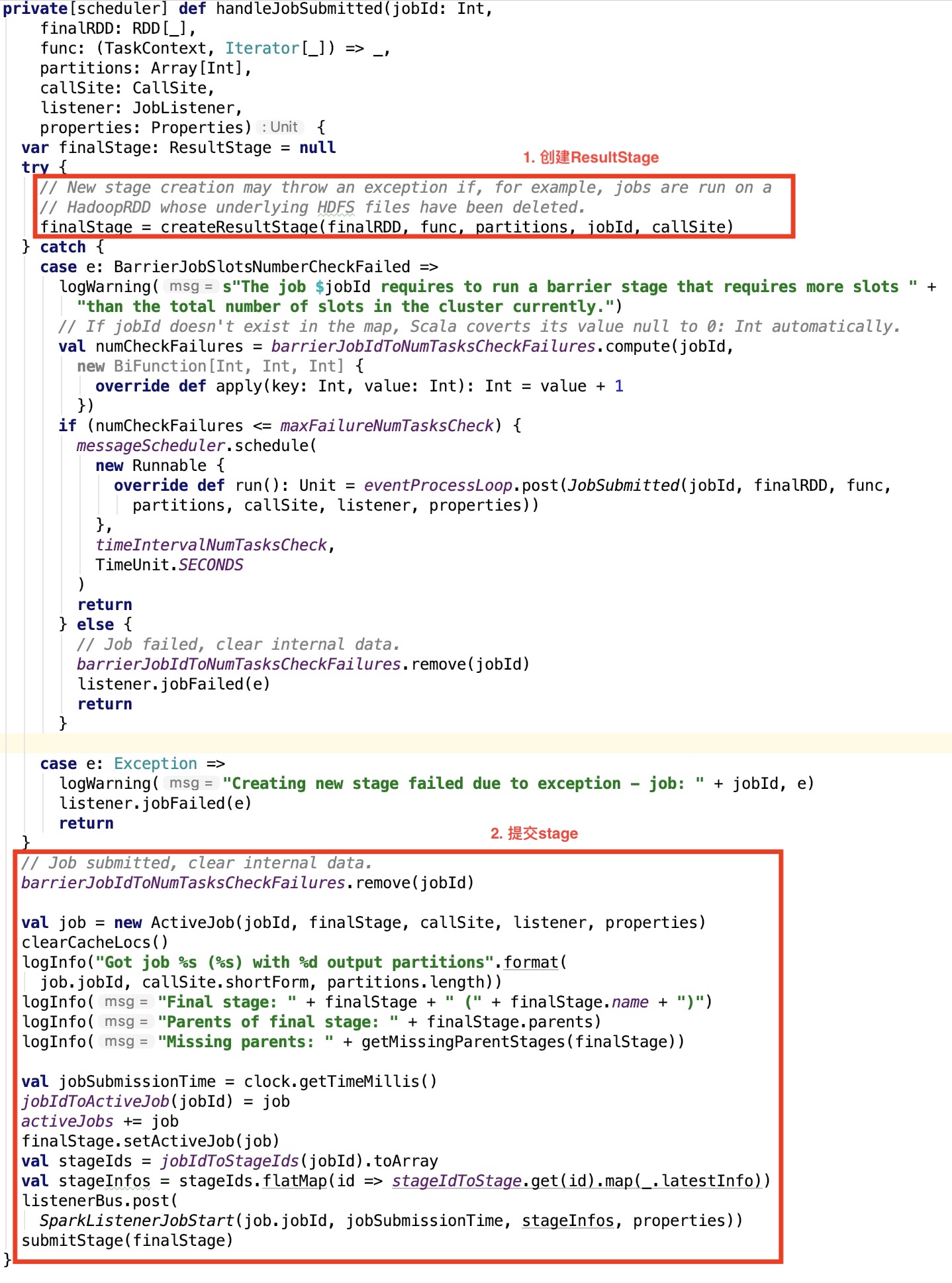
这个方法里面有两步:
- 创建ResultStage
- 提交Stage
本篇文章,我们只分析第一步,第二步在下篇文章分析。
createResultStage 方法如下:
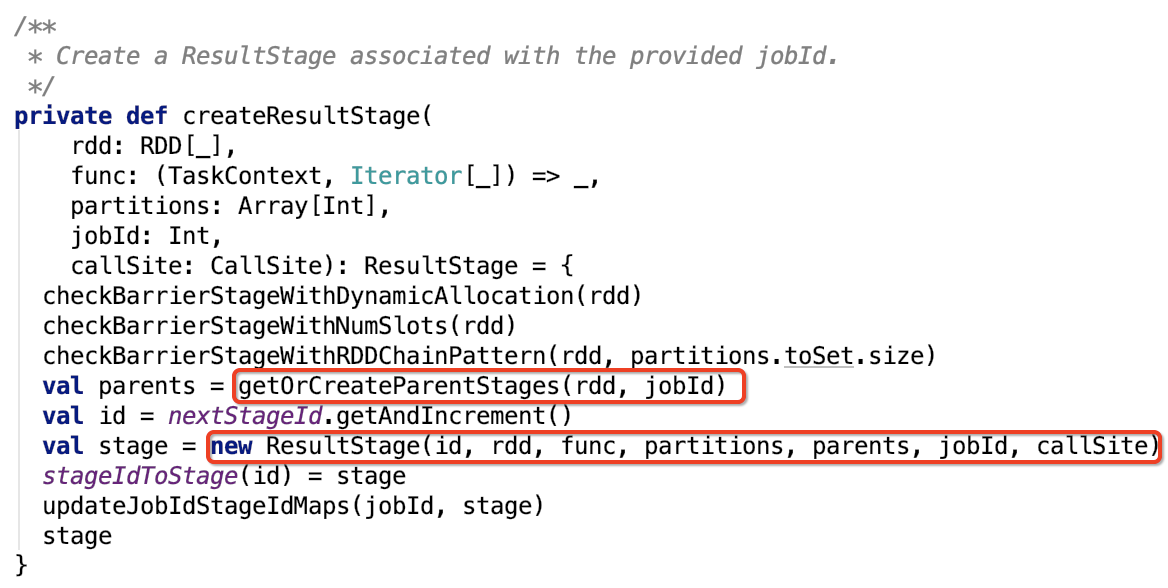
getOrCreateParentStage 方法创建或获取该RDD的Shuffle依赖关系,然后根据shuffle依赖进而划分stage,源码如下:

获取其所有父类的shuffle依赖,getShuffleDependency 方法如下,类似于树的深度遍历。
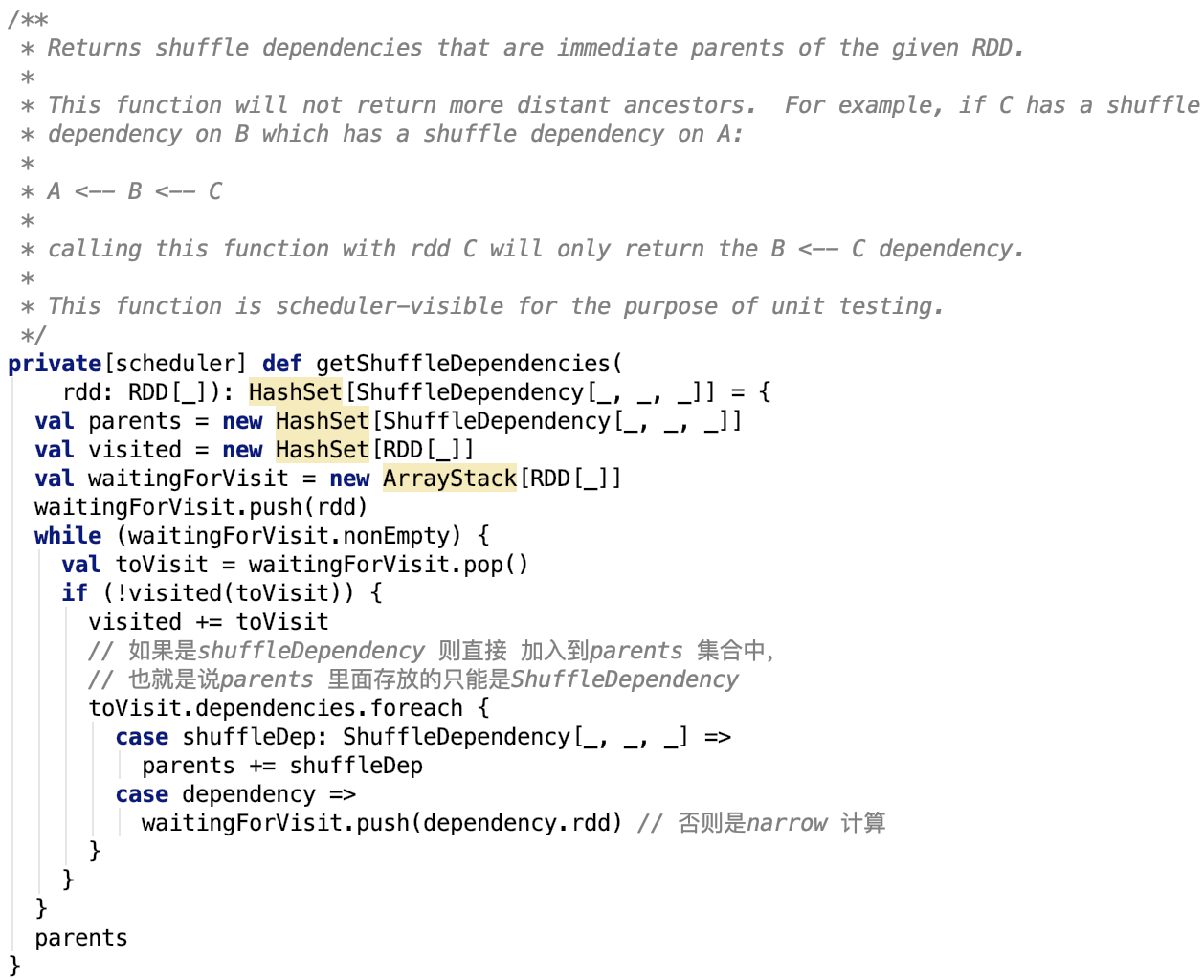
getOrCreateShuffleMapStage方法根据shuffle依赖创建ShuffleMapStage,如下,思路,先查看当前stage是否已经记录在shuffleIdToMapStage变量中,若存在,表示已经创建过了,否则需要根据依赖的RDD去找其RDD的shuffle依赖,然后再创建shuffleMapStage。
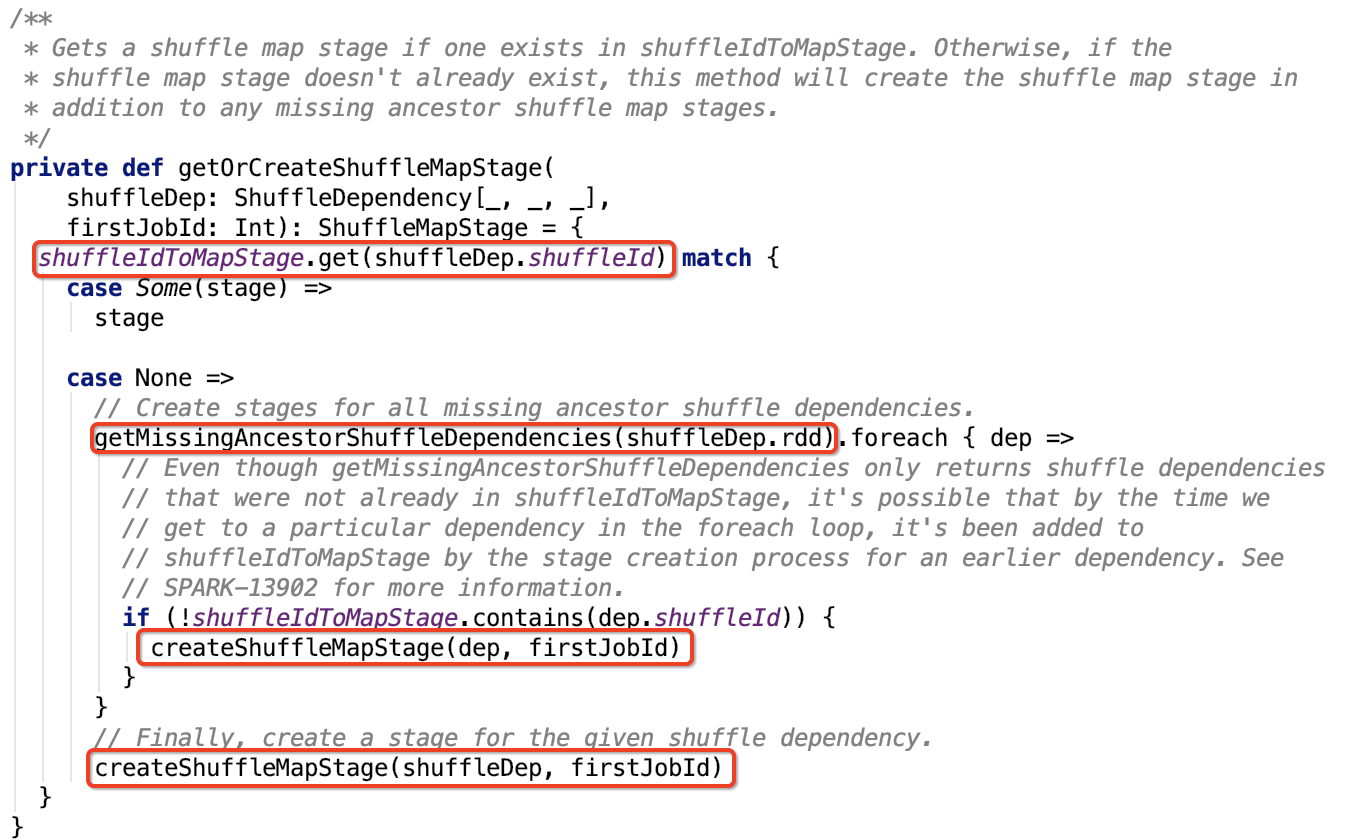
shuffleIdToMapStage定义如下:

这个map中只包含正在运行的job的stage信息。
其中shuffle 依赖的唯一id 是:shuffleId,这个id 是 SpackContext 生成的全局shuffleId。
getMissingAncestorShuffleDependencies 方法如下,思路:深度遍历依赖关系,把所有未运行的shuffle依赖都找到。

到此,所有寻找shuffle依赖关系的的逻辑都已经剖析完毕,下面看创建MapShuffleStage的方法,
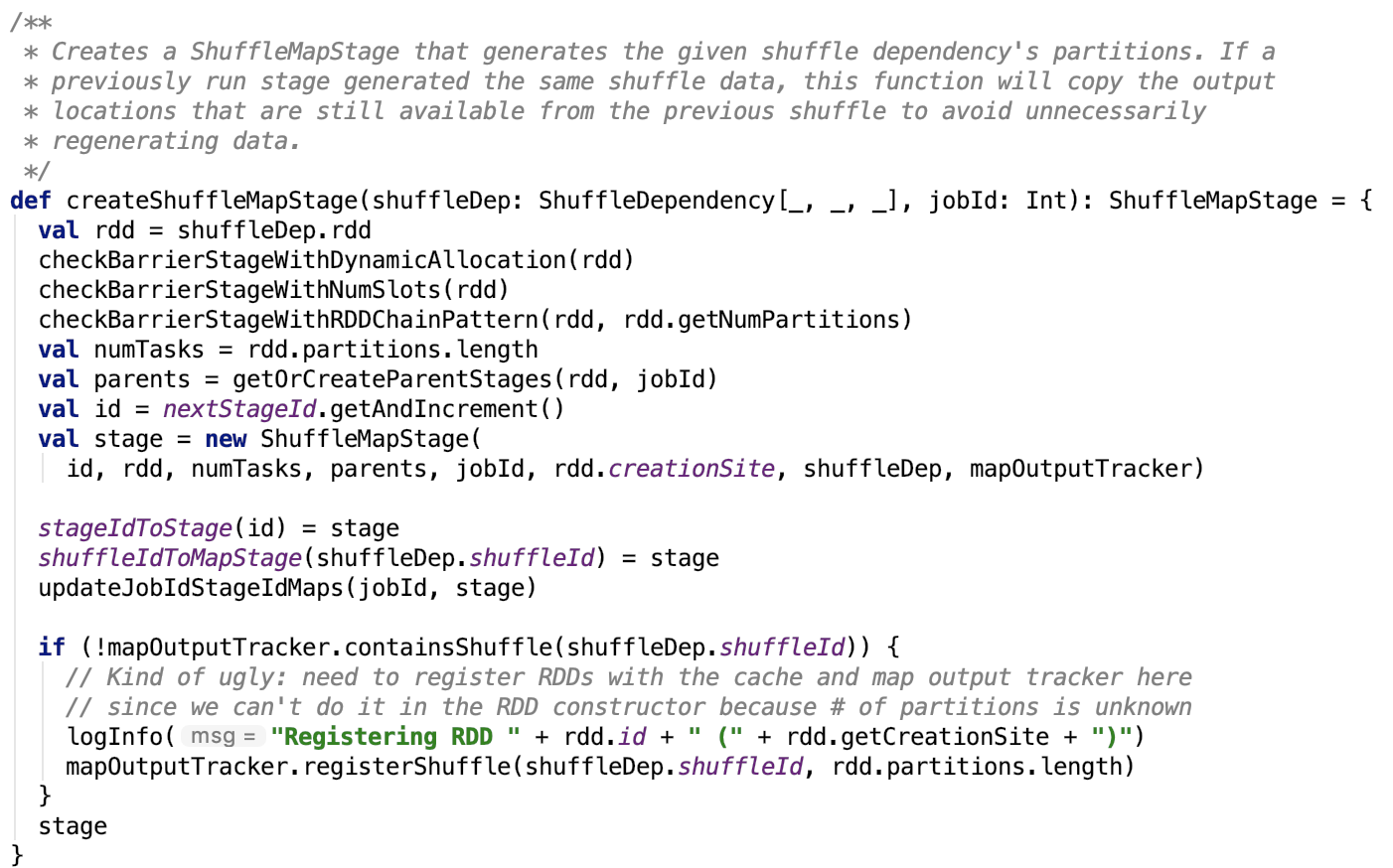
思路:生成ShuffleMapStage,并更新 stageIdToStage变量,更新shuffleIdToMapStage变量,如果 MapOutputTrackerMaster 中没有注册过该shuffle,需要注册,最后返回ShuffleMapStage对象。
updateJobIdStageIdMaps方法如下,思路该ResultStage依赖的所有ShuffleMapStage的jobId设定为指定的jobId,即跟ResultStage一致的jobId:

至此,stage的划分逻辑剖析完毕。
总结
本篇文章对照官方文档,说明了RDD的主要操作,action和transformation,进一步引出了RDD的依赖关系,最后剖析了DAGScheduler根据shuffle依赖划分stage的逻辑。
注:文章中图片来源于 Spark 论文,论文地址:http://people.csail.mit.edu/matei/papers/2012/nsdi_spark.pdf
spark 源码分析之十九 -- DAG的生成和Stage的划分的更多相关文章
- spark 源码分析之十九 -- Stage的提交
引言 上篇 spark 源码分析之十九 -- DAG的生成和Stage的划分 中,主要介绍了下图中的前两个阶段DAG的构建和Stage的划分. 本篇文章主要剖析,Stage是如何提交的. rdd的依赖 ...
- spark 源码分析之十二 -- Spark内置RPC机制剖析之八Spark RPC总结
在spark 源码分析之五 -- Spark内置RPC机制剖析之一创建NettyRpcEnv中,剖析了NettyRpcEnv的创建过程. Dispatcher.NettyStreamManager.T ...
- spark 源码分析之十五 -- Spark内存管理剖析
本篇文章主要剖析Spark的内存管理体系. 在上篇文章 spark 源码分析之十四 -- broadcast 是如何实现的?中对存储相关的内容没有做过多的剖析,下面计划先剖析Spark的内存机制,进而 ...
- spark 源码分析之十六 -- Spark内存存储剖析
上篇spark 源码分析之十五 -- Spark内存管理剖析 讲解了Spark的内存管理机制,主要是MemoryManager的内容.跟Spark的内存管理机制最密切相关的就是内存存储,本篇文章主要介 ...
- spark 源码分析之十八 -- Spark存储体系剖析
本篇文章主要剖析BlockManager相关的类以及总结Spark底层存储体系. 总述 先看 BlockManager相关类之间的关系如下: 我们从NettyRpcEnv 开始,做一下简单说明. Ne ...
- spark 源码分析之十--Spark RPC剖析之TransportResponseHandler、TransportRequestHandler和TransportChannelHandler剖析
spark 源码分析之十--Spark RPC剖析之TransportResponseHandler.TransportRequestHandler和TransportChannelHandler剖析 ...
- ABP源码分析二十九:ABP.MongoDb
这个Module通过建立一个MongoDbRepositoryBase<TEntity> 基类,封装了对MongoDb数据库的操作. 这个module通过引用MongoDB.Driver, ...
- ABP源码分析三十九:ABP.Hangfire
ABP对HangFire的集成主要是通过实现IBackgroundJobManager接口的HangfireBackgroundJobManager类完成的. HangfireBackgroundJo ...
- Vue.js 源码分析(二十九) 高级应用 transition-group组件 详解
对于过度动画如果要同时渲染整个列表时,可以使用transition-group组件. transition-group组件的props和transition组件类似,不同点是transition-gr ...
随机推荐
- IIS上.net注册
如果先安装了.Net平台,后再安装IIS,那么在IIS中可能就没有出现ASP.NET版本的下拉菜单,这是我们可手动注册.Net 一般.Net版本都存放在:C:\WINDOWS\Microsoft.NE ...
- reset.css(样式重置)
CSS Reset,意为重置默认样式.HTML中绝大部分标签元素在网页显示中都有一个默认属性值,通常为了避免重复定义元素样式,需要进行重置默认样式(CSS Reset).举几个例子:1.淘宝(CSS ...
- Linux下python多版本多环境介绍
一.python多版本配置说明 安装python相关依赖 [root@centos6 ~]# yum install -y gcc make patch gdbm-devel openssl-dev ...
- Redis---学习笔记(更新中)
一.基本命令 #查看所有键 keys * #查看指定键 keys key #查看模糊键 keys ke* keys ke? keys ke[a-z] keys ke\? #判断键是否存在 exists ...
- Verilog写一个对数计算模块Log2(x)
网上一个能用的也没有,自己写一个把. 1.计算原理: 整数部分 网上找到了一个c语言的计算方法如下: int flog2(float x) { return ((unsigned&)x> ...
- Docker-CE 安装(centos7)
配置yum源 > cd /etc/yum.repos.d/ > mkdir repo_bak > mv *.repo repo_bak/ > wget http://mirro ...
- Hive —— 安装部署
一.安装Hive 1.1 下载并解压 下载所需版本的Hive,这里我下载版本为cdh5.15.2.下载地址:http://archive.cloudera.com/cdh5/cdh/5/ # 下载后进 ...
- spring boot 2.x 系列 —— spring boot 实现分布式 session
文章目录 一.项目结构 二.分布式session的配置 2.1 引入依赖 2.2 Redis配置 2.3 启动类上添加@EnableRedisHttpSession 注解开启 spring-sessi ...
- spring 5.x 系列第15篇 —— 整合dubbo (xml配置方式)
文章目录 一. 项目结构说明 二.项目依赖 三.公共模块(dubbo-common) 四. 服务提供者(dubbo-provider) 4.1 productService是服务的提供者( 商品数据用 ...
- Google Chrome浏览器插件入门开发
--1. 在html文件中引用js 文件 --2.在Google Chrome中开发简单插件 1.首先,简单说明一下在html 中引用js 文件: 将kittenbook.html 和 kittenb ...
